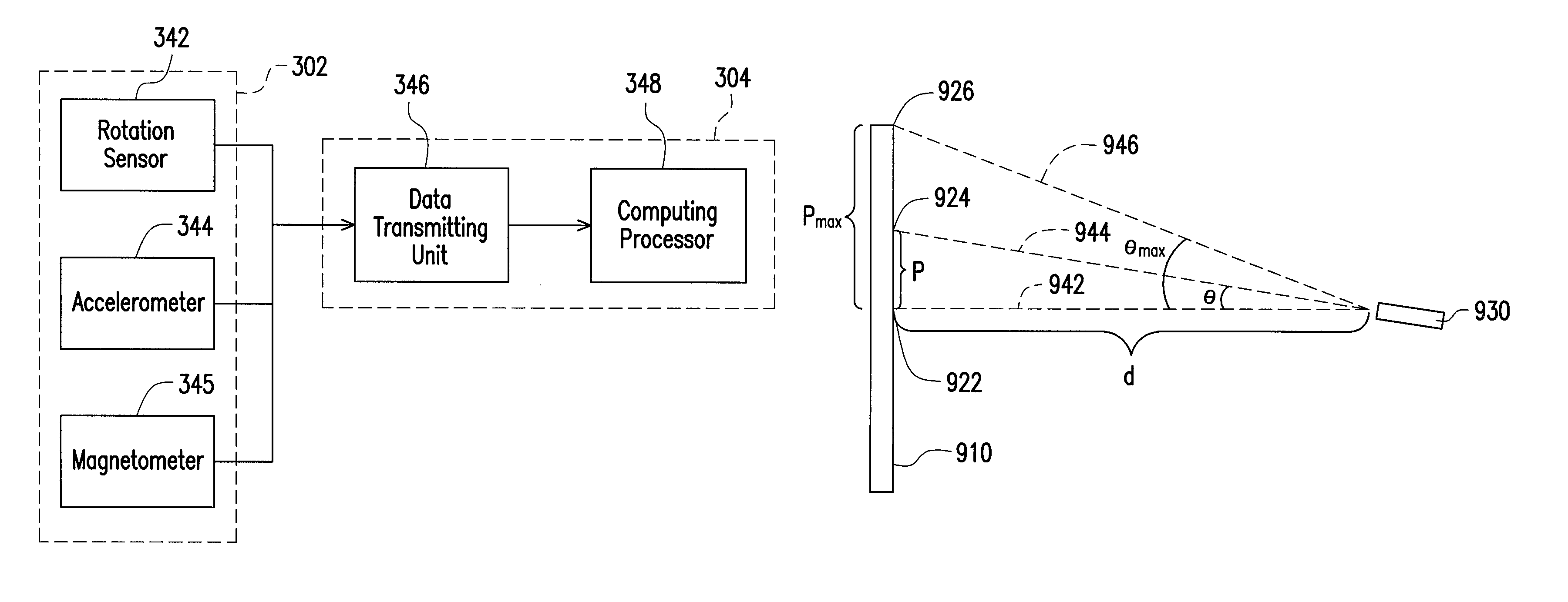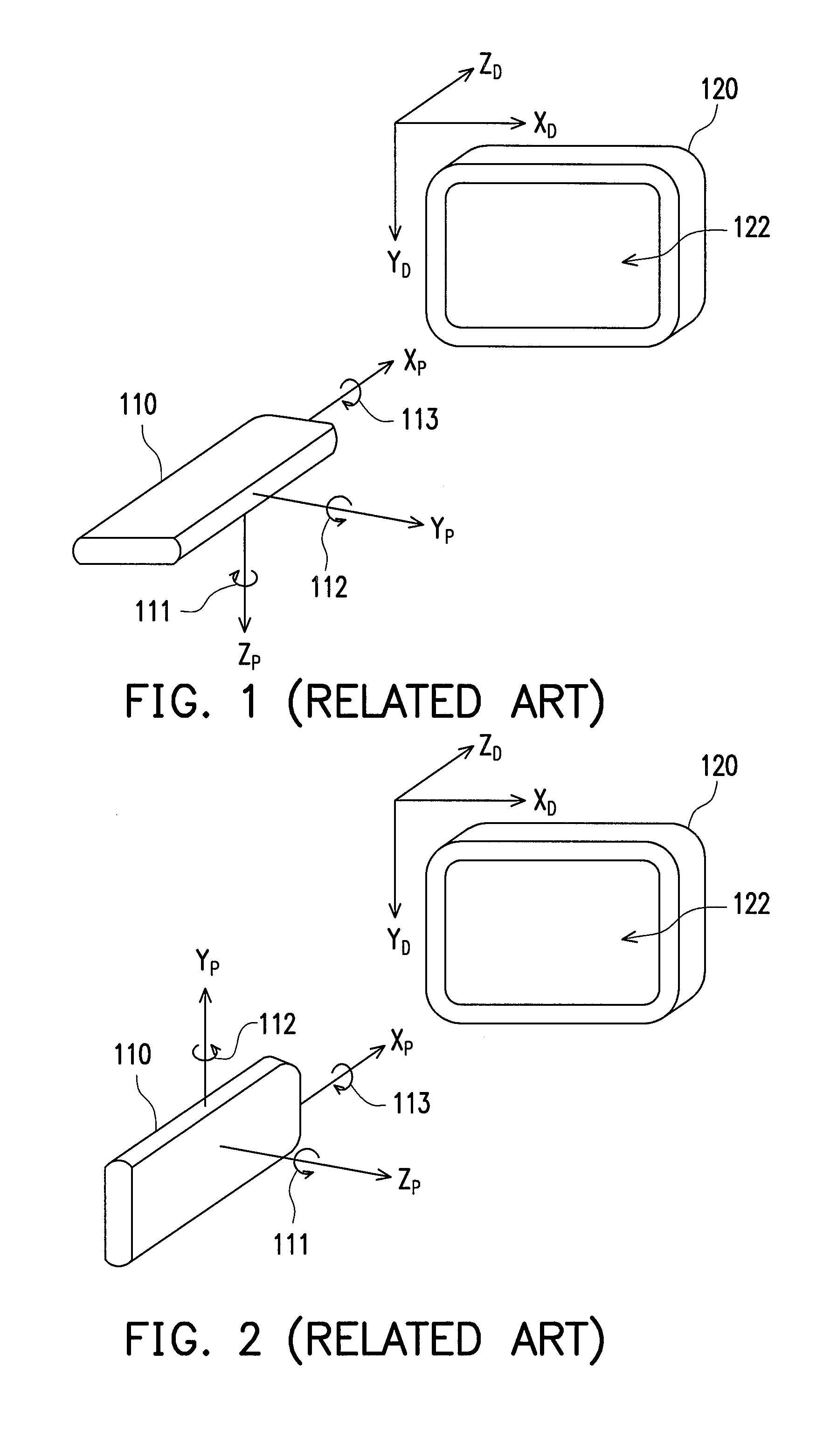[0011]According to one aspect of an exemplary embodiment of the present invention, an electronic device utilizing a nine-axis motion sensor module for use in for example computers,
motion detection or navigation is provided. The electronic device comprises an
accelerometer to measure or detect axial accelerations Ax, Ay, Az, a
magnetometer to measure or detect
magnetism Mx, My, Mz and a
rotation sensor to measure or detect angular velocities ωx, ωy, ωz such that resulting deviation including
resultant angles comprising
yaw,
pitch and roll angles in a spatial pointer frame of the electronic device subject to movements and rotations in dynamic environments may be obtained and such that said resulting deviation including said
resultant angles may be obtained and outputted in an absolute manner reflecting or associating with the actual movements and rotations of the electronic device of the present invention in said spatial pointer reference frame and preferably excluding undesirable external interferences in the dynamic environments.
[0012]According to another aspect of the present invention, the present invention provides an enhanced comparison method and / or model to eliminate the accumulated errors as well as noises over time associated with signals generated by a combination of motion sensors, including the ones generated by accelerometers Ax, Ay, Az, the ones generated by magnetometers Mx, My, Mz and the ones generated by gyroscopes ωx, ωy, ωx in dynamic environments. In other words, accumulated errors associated with a fusion of signals from a motions sensor module comprising a plurality of motion sensors to detect movements on and rotations about different axes of a reference frame may be eliminated or corrected.
[0013]According to still another aspect of the present invention, the present invention provides an enhanced comparison method to correctly calculating and outputting a resulting deviation comprising a set of
resultant angles including
yaw,
pitch and roll angles in a spatial pointer frame, preferably about each of three orthogonal coordinate axes of the spatial pointer reference frame, by comparing signals of rotation sensor related to angular velocities or rates with the ones of
accelerometer related to axial accelerations and the ones of
magnetometer related to
magnetism such that these angles may be accurately outputted and obtained, which may too be further mapping to another reference frame different from said spatial pointer frame.
[0014]In the event of interferences including external interferences introduced by either the device user or the surrounding environment, such as external electromagnetic fields, according to still another aspect of the present invention, the present invention provides a unique update program comprising a
data association model to intelligently process signals received from a motion sensor module to output a resultant deviation preferably in 3D reference frame such that the adverse effects caused by the interferences may be advantageously reduced or compensated.
[0016]According to another example embodiment of the present invention, an electronic device capable of generating 3D deviation angles and for use in for example computers,
motion detection or navigation is provided. The electronic device may utilize a nine-axis motion sensor module with an enhanced comparison method or model for eliminating accumulated errors of said nine-axis motion sensor module to obtain deviation angles corresponding to movements and rotations of said electronic device in a spatial pointer reference frame. The comparison method or model may be advantageously provided by comparing signals from the abovementioned nine-axis motion sensor module capable of detecting rotation rates or angular velocities of the electronic device about all of the XP, YP and ZP axes as well as axial accelerations and ambient
magnetism including such as Earth's
magnetic field or that of other planets of the electronic device along all of the XP, YP and ZP axes such that deviation angles of the resultant deviation of the electronic device of the present invention may be preferably obtained or outputted in an absolute manner. In other words, the present invention is capable of accurately outputting the abovementioned deviation angles including yaw, pitch and roll angles in a 3D spatial pointer reference frame of the 3D pointing device to eliminate or reduce accumulated errors and noises generated over time in a dynamic environment including conditions such as being subject to a combination of continuous movements, rotations, external gravity forces,
magnetic field and additional extra accelerations in multiple directions or movement and rotations that are continuously nonlinear with respect to time; and furthermore, based on the deviation angles being compensated and accurately outputted in 3D spatial reference frame may be further mapped onto or translated into another reference frame such as the abovementioned display frame, for example a reference in two-dimension (2D).
[0018]According to another example embodiment of the present invention, a method for compensating accumulated errors of signals of the abovementioned nine-axis motion sensor module in dynamic environments associated in a spatial reference frame is provided. In one embodiment, the method may be performed or handled by a hardware processor. The processor is capable of compensating the accumulated errors associated with the resultant deviation in relation to the signals of the abovementioned nine-axis motion sensor module of the 3D pointing device subject to movements and rotations in a spatial reference frame and in a dynamic environment by performing a data comparison to compare signals of rotation sensor related to angular velocities with the ones of accelerometer related to axial accelerations and the ones of
magnetometer related to magnetism such that the resultant deviation corresponding to the movements and rotations of the 3D pointing device in the 3D spatial reference frame may be obtained accurately over time in the dynamic environments.
 Login to View More
Login to View More  Login to View More
Login to View More 


